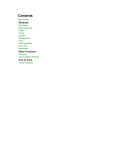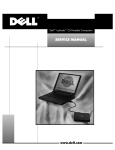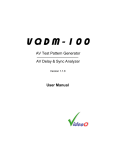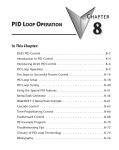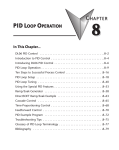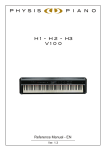Download Process Control - Multi-Process Station, Model 3505 - Lab-Volt
Transcript
Process Control Multi-Process Station Courseware Sample 85629-F0 85629-00 Order no.: First Edition Revision level: 06/2015 By the staff of Festo Didactic © Festo Didactic Ltée/Ltd, Quebec, Canada 2009 Internet: www.festo-didactic.com e-mail: [email protected] Printed in Canada All rights reserved ISBN 978-2-89640-379-0 (Printed version) Legal Deposit – Bibliothèque et Archives nationales du Québec, 2009 Legal Deposit – Library and Archives Canada, 2009 The purchaser shall receive a single right of use which is non-exclusive, non-time-limited and limited geographically to use at the purchaser's site/location as follows. The purchaser shall be entitled to use the work to train his/her staff at the purchaser's site/location and shall also be entitled to use parts of the copyright material as the basis for the production of his/her own training documentation for the training of his/her staff at the purchaser's site/location with acknowledgement of source and to make copies for this purpose. In the case of schools/technical colleges, training centers, and universities, the right of use shall also include use by school and college students and trainees at the purchaser's site/location for teaching purposes. The right of use shall in all cases exclude the right to publish the copyright material or to make this available for use on intranet, Internet and LMS platforms and databases such as Moodle, which allow access by a wide variety of users, including those outside of the purchaser's site/location. Entitlement to other rights relating to reproductions, copies, adaptations, translations, microfilming and transfer to and storage and processing in electronic systems, no matter whether in whole or in part, shall require the prior consent of Festo Didactic GmbH & Co. KG. Information in this document is subject to change without notice and does not represent a commitment on the part of Festo Didactic. The Festo materials described in this document are furnished under a license agreement or a nondisclosure agreement. Festo Didactic recognizes product names as trademarks or registered trademarks of their respective holders. All other trademarks are the property of their respective owners. Other trademarks and trade names may be used in this document to refer to either the entity claiming the marks and names or their products. Festo Didactic disclaims any proprietary interest in trademarks and trade names other than its own. Safety and Common Symbols The following safety and common symbols may be used in this manual and on the equipment: Symbol Description DANGER indicates a hazard with a high level of risk which, if not avoided, will result in death or serious injury. WARNING indicates a hazard with a medium level of risk which, if not avoided, could result in death or serious injury. CAUTION indicates a hazard with a low level of risk which, if not avoided, could result in minor or moderate injury. CAUTION used without the Caution, risk of danger sign , indicates a hazard with a potentially hazardous situation which, if not avoided, may result in property damage. Caution, risk of electric shock Caution, hot surface Caution, risk of danger Caution, lifting hazard Caution, hand entanglement hazard Notice, non-ionizing radiation Direct current Alternating current Both direct and alternating current Three-phase alternating current Earth (ground) terminal Safety and Common Symbols Symbol Description Protective conductor terminal Frame or chassis terminal Equipotentiality On (supply) Off (supply) Equipment protected throughout by double insulation or reinforced insulation In position of a bi-stable push control Out position of a bi-stable push control We invite readers of this manual to send us their tips, feedback, and suggestions for improving the book. Please send these to [email protected]. The authors and Festo Didactic look forward to your comments. Table of contents Introduction . . . . . . . . . . . . . . . . . . . . . . . . . . . . . . . . . . . . . . . . . . . . . . . . . . . . V Exercise 1 Level Measurement I – Dry Method using a Bubble Pipe . . . . . . . . . . . . . . . . . . . . . . . . . . . . . . . . . 1-1 Exercise 2 Level Measurement II – Calibration of a Level Transmitter . . . . . . . . . . . . . . . . . . . . . . . . . . . . . . . . 2-1 Exercise 3 Pressure Measurement . . . . . . . . . . . . . . . . . . . . . . . . . . . . . . . 3-1 Exercise 4 Flow Measurement: Differential Pressure vs Flow Using a Venturi or Orifice Plate . . . . . . . . . . . . . . . . . 4-1 Exercise 5 Level Process Characteristics with Control Valve . . . . . . . . . . . . . . . . . . . . . . . . . . . . . . . . . . . 5-1 Exercise 6 Level Process Characteristics with Variable Speed Pump . . . . . . . . . . . . . . . . . . . . . . . . . . . . . . . . 6-1 Exercise 7 Flow Process Characteristic with Control Valve . . . . . . . . . . 7-1 Exercise 8 Pressure Process Characteristic . . . . . . . . . . . . . . . . . . . . . . . 8-1 Exercise 9 Proportional Control – Level Process with Control Valve . . . . . . . . . . . . . . . . . . . . . . . . . . . . . . . . . . . 9-1 Exercise 10 Proportional Control – Flow Process with Variable Speed Pump . . . . . . . . . . . . . . . . . . . . . . . . . . . 10-1 Exercise 11 Proportional Plus Integral Control – Level Process with Control Valve . . . . . . . . . . . . . . . . . . . . . . . . . . . . . . . . . . 11-1 Exercise 12 Proportional Plus Integral Control – Pressure Process . . . . . . . . . . . . . . . . . . . . . . . . . . . . . . . . . . 12-1 Exercise 13 Proportional Plus Integral Plus Derivative Control – Level Process with Control Valve . . . . . . . . . . . . . . . . . . . . . 13-1 Exercise 14 Proportional Plus Integral Plus Derivative Control – Flow Process with Variable Speed Pump . . . . . . . . . . . . . . . 14-1 Exercise 15 Ultimate Period Tuning of a Level Process . . . . . . . . . . . . . . 15-1 Exercise 16 Ultimate Period Tuning of a Flow Process – Approximation Method . . . . . . . . . . . . . . . . . . . . . . . . . . . . . . 16-1 Exercise 17 Open Loop Tuning of a Level Process using the Reaction Rate Method . . . . . . . . . . . . . . . . . . . . . . 17-1 Exercise 18 Open Loop Tuning of a Pressure Process . . . . . . . . . . . . . . 18-1 Exercise 19 Troubleshooting a Level Control Process . . . . . . . . . . . . . . 19-1 III 7DEOHRI&RQWHQWVFRQW¶G ([HUFLVH 2SHUDWLRQRID7ZR(OHPHQW&RQWURO3URFHVV ([HUFLVH 7KUHH(OHPHQW&RQWURO3URFHVV ([HUFLVH $XWR7XQH&RQWUROOHU $SSHQGL[ $ 6\PEROV8VHGLQ'LDJUDPV % 9HQWXUL7XEH)ORZ&XUYH %LEOLRJUDSK\ 5HIHU WR PDQXDO ( 8VHU *XLGH IRU IXUWKHU LQIRUPDWLRQ UHJDUGLQJ WKH 9DULDEOH 6SHHG 'ULYH 3RZHU)OH[ WKH 3DSHUOHVV 5HFRUGHU DQG WKH 0LFURSURFHVVRU%DVHG&RQWUROOHU 1RWHWKDWZKHQXVLQJWKH3DSHUOHVV5HFRUGHUWKHRKPUHVLVWDQFHLVQRWSDUWRI WKHHOHFWULFDOZLULQJ IV Introduction The rapid advances of instrumentation technology have greatly expanded the variety of tasks performed by instrument technicians at industrial plants. Technicians are tasked with calibrating, troubleshooting and repairing instruments ranging from pneumatic booster relays to microprocessor based automatic controllers. To successfully perform these tasks without adversely affecting plant availability or maintenance costs, effective training is essential. The Lab-Volt Mobile Process Control Trainers are designed for hands-on training in the measurement, control and troubleshooting of processes. The stations can operate independently, or in certain combination configurations to simulate complex processes. All instruments in the Lab-Volt Mobile Instrumentation and Process Control System are patch connected to permit alternate control schemes and adaptation of new technology in the future. The Flow, Level, Multi-Process, Heat Exchanger and Analytic stations utilize water as the process media, while Pressure and Temperature stations are based on air. The student's manual introduces the instrumentation students to the basic characteristics of the main process variables. As the program progresses, students will proceed to study process fundamentals, calibration of sensing devices and transmitters, operation of microprocessor-based controller. Closed loop control and troubleshooting complete the program. V Sample Exercises Extracted from Student Manual Exercise 2 Level Measurement II – Calibration of a Level Transmitter OBJECTIVES At the completion of this exercise, you will be able to calibrate a differential pressure transmitter, using the process, to measure level. DISCUSSION A Differential Pressure (D/P) Transmitter may be used for the measurement of liquid level or flow of a fluid in a pipe. In this exercise you will calibrate the Differential Pressure Transmitter by varying the height of the water column in the level tank. A Differential Pressure Transmitter measures the difference of pressure applied across its measuring element. The differential pressure detected by the Differential Pressure Transmitter is related to a column of fluid by the following relationship: Pressure = Density of fluid x Height of fluid Differential pressure transmitters produce an output proportional to the difference in pressure across its high pressure, and low pressure ports. The height of fluid is normally expressed in inches/centimeters of water. If the density of the fluid remains constant, which is normally the case, then the pressure is directly related to the height of the fluid. Therefore, accurately determined, reproducible pressures can be applied to a Differential Pressure Transmitter by varying the height of a column of fluid of a known density. Calibration of a Differential Pressure Transmitter is the process of matching the zero and full scale outputs of the transmitter to the minimum and maximum differential pressures applied. The actual differential pressures that are to be applied to the Differential Pressure Transmitter are derived from the specific application. As for most transmitters, the two adjustments available for the calibration are the zero and span of range. It is necessary to determine the upper and lower range values of differential pressures which will be applied to the transmitter. The level process tank is graduated in centimeters and inches. The bottom of the tank has two pressure taps, and mini valves labelled V6 and V7. If the tank overflow valve V13 is opened, then the tank will be vented to atmosphere, and we need only to connect the high pressure part of the D/P transmitter to V6 and V7. The tank level will provide a pressure on the D/P cell proportional to its height, and the D/P electronics will give a current output of 4-20 mA equivalent to the range the D/P cell is calibrated to. When we connect the D/P cell to the bottom of the tank, two problems occur: 1) The air trapped in the tubing will compress as the water column height increases. This requires that the D/P cell be opened to release the trapped air, which is a technique called “bleeding” the sensing lines and the D/P cell. 2-1 Level Measurement II – Calibration of a Level Transmitter 2) The “bottom” of the tank is not necessarily the real bottom of the water column. The actual “bottom” is the lowest point of the tubing in relationship to the height of the D/P cell. To solve 1) we must “bleed” the tubing and the D/P cell to ensure no air is trapped. All D/P cells have small vents to permit this. To solve 2) we must adjust the electronics to “elevate” or “suppress” the zero output of the D/P cell (4.0 mA) to be equal to the real level “zero” in the tank. Again this is not always the bottom of the tank. In this exercise we calibrate the transmitter for a zero = 4" of water and a span of 20 inches of water. This means our range will be 4-24 inches of water. Range span = zero. EQUIPMENT REQUIRED DESCRIPTION MODEL Multi-Process Station D/P Transmitter (LT) Digital Multimeter 3505-M0 INSTRUMENT DATA DEVICE MODEL SERIAL NO. LT CALIBRATED 0-30" WC/4-20 mA PROCEDURE CAUTION! Water and electric power are present in this laboratory exercise. Be careful of possible electrical shock hazard. 2-2 G 1. Connect the equipment as shown in Figure 2-2. Open or close the valves as shown. G 2. Program the variable speed drive for manual operation. Close valve V8. G 3. Start the pump and fill the level tank to 26 inches (65 cm) and close valve V2. Stop the pump. G 4. In this step you will bleed the air from the tubing between V7 and the D/P cell. Using a small wrench, open the D/P cell high side vent, and bleed the cell into a small cup. You need to bleed 2 or 3 inches of water into the cup to ensure all air is out. Close the D/P cell vent. Level Measurement II – Calibration of a Level Transmitter G 5. Check again that the water level in the tank is exactly 24 inches (60 cm). If not, add or release water until correct. G 6. Following the procedure in the manufacturers’ manual for the specific D/P Transmitter, set the span adjust so that the transmitter output, as indicated on the DMM, reads 20.0 mA. G 7. Open V8 and drain the tank level down to 4 inches or 10 cm and close V8. As for step 6, follow the manufacturers’ instruction for setting zero, and set the zero adjust so that 4.0 mA is indicated on the DMM. G 8. Refill the tank to 24 inches (60 cm) and reset the span adjust for 20 mA. Drain the tank to 4 inches (10 cm) and reset the zero to 4 mA. Some transmitters require that you repeat this several times because the zero and span adjustments are often interactive. New microprocessor based instruments have virtually no interaction, and the zero/span need only to be set once. G 9. Note that we have set the zero at 4 inches (10 cm) and upper range to 24 inches (60 cm) for a 20 inches (56 cm) span. If time permits recalibrate the D/P transmitter to a zero of 10" (25 cm) and an upper range value of 20" (50 cm). G 10. Complete the calibration data sheet and plot a graph of the results. Check to see if there is any non-linearity on hysteresis visible. CONCLUSION In this exercise you learned to calibrate a Differential Pressure Transmitter. You observed the interaction of the zero and span adjustments for a specified range of operation. The zero adjustment does not normally affect the span/range adjustment. However, the span/range adjustment does affect the zero adjustment. You also learned that a Differential Pressure Transmitter needs to be vented to produce correct readings. 2-3 Level Measurement II – Calibration of a Level Transmitter CALIBRATION DATA SHEET APPLICATION DATA INSTRUMENT NAMEPLATE DATA INSTRUMENT NUMBER: MANUFACTURERS NAME: FUNCTION: MODEL NUMBER: LOCATION: SERIAL NUMBER: INPUT RANGE: OUTPUT RANGE: REQUIRED ACCURACY: DATE OF CALIBRATION: INPUT % SPAN DESIRED OUTPUT ACTUAL OUTPUT REMARKS 0 25 50 75 100 75 50 25 0 ALARMS ALARM FUNCTION: ALARM SETTINGS: LOW SETPOINT 2-4 ACTUAL TRIP POINT HIGH SETPOINT ACTUAL TRIP POINT Level Measurement II – Calibration of a Level Transmitter Figure 2-1. 2-5 Level Measurement II – Calibration of a Level Transmitter Figure 2-2A. 2-6 Level Measurement II – Calibration of a Level Transmitter Figure 2-2B. REVIEW QUESTIONS 1. What is the function of a Differential Pressure Transmitter in a level measurement channel? 2. Why is it necessary to purge all air from the transmitter before using water as the calibration medium? 2-7 Exercise 15 Ultimate Period Tuning of a Level Process OBJECTIVES At the completion of this laboratory exercise you will be able to use standard process instrumentation to observe and analyze the effects of setpoint and gain changes on a controller and, using the observed information, determine the optimum settings required to tune the controller. DISCUSSION The basic purpose of tuning is to match the P + I + D settings within the controller, to the dynamics of the process. There are two basic approaches to loop tuning: a) Open loop, which we will examine later, and b) closed loop, which places the process in oscillation. The desirable goal is to upset or disturb the process just enough to determine the PID values without upsetting the plant. There are many theoretical tuning methods. In this exercise we will examine the ultimate period or Ziegler-Nichols method. Because overall plant efficiency relies heavily on optimum tuning of all processes in the plant, it is important to understand this method of tuning. In Exercises 9 and 12 we have observed that increasing the controller gain may lead to increased instability. Any control loop will oscillate in the controller gain (KP) is high enough. The period of the oscillation is called the natural or ultimate period (PU). The ultimate period method requires placing the process in continuous amplitude oscillation and then using the controller setting and measurements from the strip chart to determine the optimum settings of gain, Integral action and derivative action for the controller and the process. Figure 15-1. 15-1 Ultimate Period Tuning of a Level Process EQUIPMENT REQUIRED DESCRIPTION MODEL Multi-Process Station including: Microprocessor PID Controller (LIC) Differential Pressure Transmitter (LT) Variable Speed Pump (VSP) Recorder (LR) 3505-M0 INSTRUMENT DATA DEVICE MODEL SERIAL NO. CALIBRATED LT 6-26" WC/4-20 mA I/P 4-20 mA/3-15 psi LR 4-20 mA/0-100% Controller Configuration (See note in Exercise 9) 1. 2. 3. 4. 5. 6. Setpoint = 50 % Gain = 1 (PB = 100 %) Reset = minimum rep/min (max. integral time min/rep) Derivative = 0.05 min. Auto/Manual = Auto Action = Reverse PROCEDURE CAUTION! Do not run pump for prolonged periods with a shut off head! 15-2 G 1. Set up and connect equipment as per the loop diagram. Valve settings as per diagram Figure 15-3. Configure the VSP to provide 0-10 GPM (36 lpm) for an input signal of 4-20 mA. G 2. Calibrate the level transmitter for 6-26" WC. G 3. Set the controller as per the Controller Configuration. G 4. Manually adjust the controller output until the measured variable equals the setpoint. Start the recorder and place the controller in automatic. The process will stabilize close to the setpoint. Ultimate Period Tuning of a Level Process G 5. Disturb the process by increasing the setpoint for 5 seconds then reduce it back to 50 %. If the chart recorder displays the process as being in continuous amplitude oscillations proceed with step 9. Otherwise proceed with step 6. G 6. Allow the process to stabilize. G 7. On the controller, increase the gain (decrease the proportional band) to give more proportional action. The normal practice is to make steps in factors of 2 (i.e. PB = 100 % Ú50 % Ú 25 % Ú 12 % Ú 6 % … etc.) G 8. Repeat steps 5 to 7 until the process responds with constant amplitude oscillations. G 9. Use the proportional setting and the period of oscillation in the ZieglerNichols equations to determine optimum controller settings. Note: Some texts show slightly different coefficients on the equations. G 10. Using the three calculated settings, evaluate the controller response to supply and demand disturbances. Fine tuning may be necessary. Changes in process gain due to transmitter and VSP calibration variations will result in values differing as much as 20 % or more. NOTES/CALCULATIONS Kp = Calculated controller gain setting PB = Calculated proportional band setting Ti = Integral time (min/repeat) RPM = Reset (repeats/min) td = Derivative time (min) Ku = Controller gain setting which resulted in constant amplitude oscillations Pu = Period of oscillation (minutes) Proportional Kp = 0.5 Ku = PB = 2 Pbu = Proportional and Reset Kp = 0.45 Ku = PB = 2.2 PBu = Ti = Pu/1.2 = RPM = 1.2/Pu = 15-3 Ultimate Period Tuning of a Level Process Proportional and Reset and Rate Kp = 0.6 Ku = PB = 1.66 PBu = Ti = Pu/2 = RPM = 2/Pu = td = Pu/8 = 15-4 Ultimate Period Tuning of a Level Process Figure 15-2. 15-5 Ultimate Period Tuning of a Level Process Figure 15-3A. 15-6 Ultimate Period Tuning of a Level Process Figure 15-3B. REVIEW QUESTIONS 1. Is the ultimate period method an open-loop or closed-loop method of controller tuning? Explain. 2. For the ultimate period method, why is the calculated gain value different for PI control and straight proportional control? 15-7 Ultimate Period Tuning of a Level Process 3. What information must be obtained to tune a controller using the ultimate period method and what is it used to determine? 15-8 Exercise 20 Operation of a Two Element Control Process OBJECTIVES At the completion of this laboratory exercise you will be able to assemble a two element flow/level control loop. This is called a cascade control system. Note: This exercise requires a second D/P Transmitter, available as an option with the 3505-M0 Station. DISCUSSION Cascade control is a natural extension of feedback control. The purpose is to increase the accuracy of the controlled variable by adding a second control loop to regulate a second controlled variable which could cause fluctuations in the primary variable. They are termed the primary loop and secondary loop, sometimes also called the master and slave. You will be aware from previous exercises that you have achieved level control by controlling flow into the level process tank. The two variables are interdependent. Level is actually the result of the difference between the rate of inflow and outflow. In this exercise you are again primarily concerned with level control. The level control loop is therefore the primary loop. However, now you will also measure and control flow as the secondary loop. The output signal from the level controller does not operate the final control element. Instead this output signal becomes the setpoint of the flow controller, therefore the term slave. If the level falls below setpoint, the level controller output increases which increases the flow controller setpoint. The flow controller output therefore increases and it is this signal which operates the final control element to bring level back up to setpoint. The increased accuracy results from the fact that the flow controller will sense any flow disturbance before it has an effect on level and can therefore minimize the disturbance immediately, rather than waiting for a feedback signal from the level transmitter. Note to the Instructor and student: This exercise can be done using either the I/P Converter and Control Valve, or using the Variable Speed Drive and pump. Because of the significant difference in speed of response, there is merit in trying both. EQUIPMENT REQUIRED DESCRIPTION MODEL Multi-Process Station Differential Pressure Transmitter (LT) Differential Pressure Transmitter (FT) Current to Pressure Converter (I/P) or Variable Speed Drive (VSD) Digital Multimeter 3505-M0 3550-M0 20-1 Operation of a Two Element Control Process INSTRUMENT DATA DEVICE MODEL SERIAL NO. CALIBRATED FT 3-10 GPM/4-20 mA I/P 4-20 mA/3-15 psi LT 6-26" WC/4-20 mA CONTROLLER CONFIGURATION (see Figure 20-1) In the first part of the procedure use controller settings obtained from previous exercises, selecting PI control mode. In the second part of the exercise, set the controller for cascade mode as shown in Figure 20-2. PROCEDURE CAUTION! Do not run pump for prolonged periods with a shut off head! G 1. Set up and connect the equipment as shown in Figure 20-2. Figure 20-1. Foxboro 761/762 Controller Configuration. G 20-2 2. Calibrate the Flow Transmitter for 3-10 GPM. Calibrate and configure the controller. Insert the Venturi Tube in the header assembly and set up a standard flow control loop. Calibrate the flow transmitter. Tune the loop using any method you are familiar with. Operation of a Two Element Control Process G 3. It is usual to tune the secondary control loop first. This loop may now be treated as a final control element. This loop will normally be “undertuned” rather than critically tuned. G 4. Calibrate the level transmitter and the I/P converter or VSD. Configure the controller for cascade mode or use two independent controllers, the flow controller set for remote setpoint from the level controller output. G 5. Connect the cascade control loop as per the loop diagram. G 6. Start the process and tune the level controller as you would for a standard single element level control loop. In this exercise, you will not be given a semi-pictorial diagram to make connections. If you have trouble understanding the Piping and Instrument Diagram shown in Figure 20-2, refer back to the diagrams shown in Exercises 14 and 15. The Foxboro 761/762 configuration is shown in block diagram form. Filter settings should be initially set to 1 min and should not be reduced below .05 min. Try various settings and observe effect on stability. Figure 20-2. Two Element Boiler Drum Level Control. 20-3 Operation of a Two Element Control Process Figure 20-3. 20-4 Operation of a Two Element Control Process REVIEW QUESTIONS 1. Is Cascade Control normally used with “fast” or “slow” processes? 2. What is the normal MODE configuration of the secondary controller? Explain. 3. Why do we tune the secondary control loop first? 20-5 Bibliography Hughes “Measurement and Control Basics” ISA 1988. Johnson “Process Control Instrumentation Technology” Wiley 1982. Murrill “Fundamentals of Process Control Theory” ISA 1981. Shinsky “Process Control Systems” McGraw-Hill 1979. Mobile Level Station Instruction Manual 75943-D0; Foxboro Insert M1020-331. Foxboro 760 User’s Manual, 1989. Foxboro 760 Instruction Manual.




































